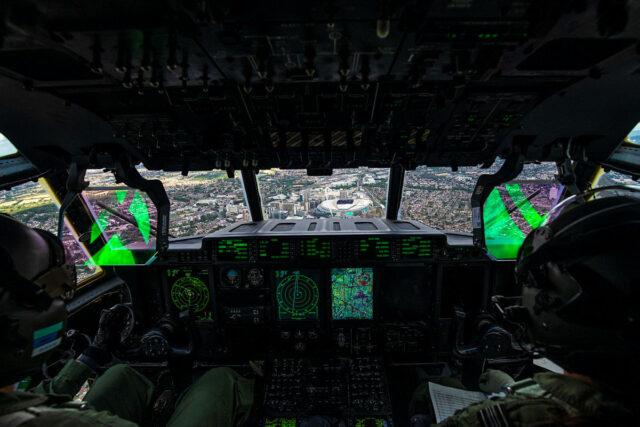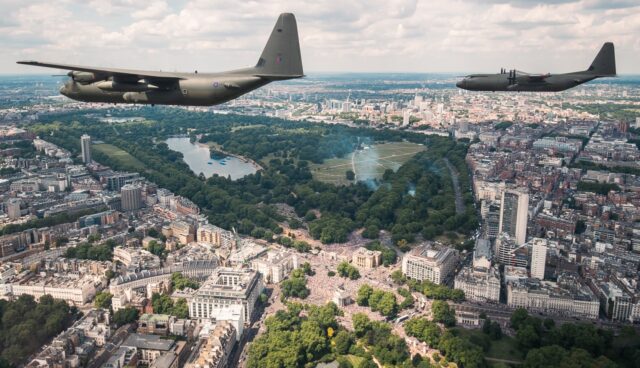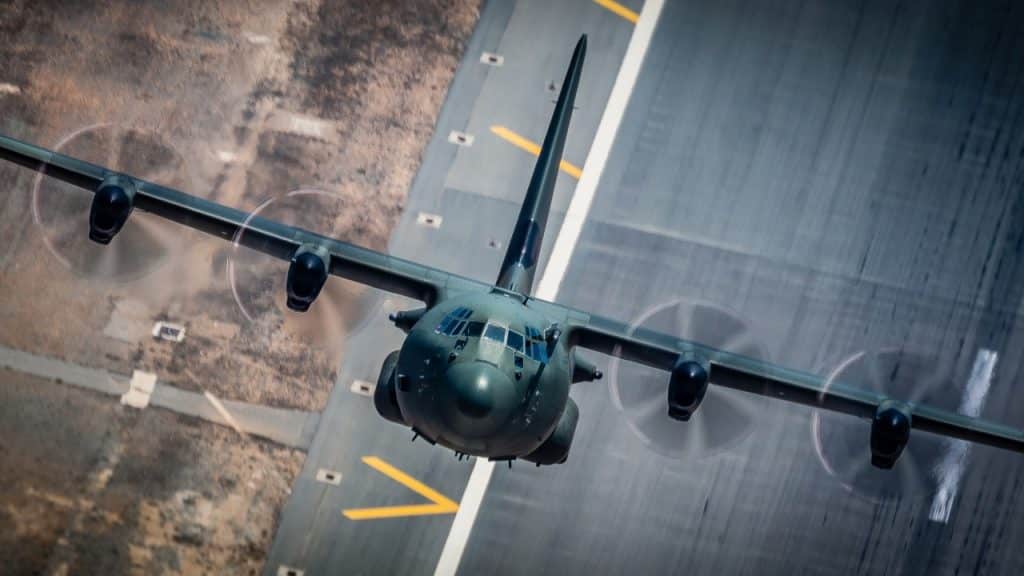The UK Ministry of Defense has put up for sale fourteen C-130J-30 transport aircraft, designated by the Royal Air Force as Hercules C.4. According to the plans included in the Defense in a Competitive Age report published in March 2021, the Hercules will be finally withdrawn in 2023. Theoretically, the reduction in the number of RAF transport aircraft is to be compensated by the introduction of a larger number of larger A400M Atlas to the armament, which in turn is to maintain the existing transport capacity. In practice, this is doubtful.
The sale is organized by Defense Equipment Sales Authority (DESA) – an organizational unit of the Ministry of Defense responsible for selling redundant equipment from the resources of the British armed forces. She cooperates with Marshall Aerospace, an aircraft maintenance company, responsible for possible repairs and general preparation of aircraft for service with the new operator.
DESA advertises the Hercules as first-class tactical transport planes capable of dropping cargo and paratroopers in areas where it would be too dangerous to land. The plane can fly day and night, and in formation in all weather conditions. Its advantage is also the modern cockpit equipment that allows the crew to be limited to two pilots. The possibility of refueling during the flight and the possibility of equipping the aircraft with the Air Survival Rescue Apparatus for the implementation of search and rescue tasks is also emphasized.
The planes are powered by four Allison AE 2100 engines with Dowty Aerospace six-blade propellers. The motor control system is fully digital built into the FADEC system. The aircraft has a curb weight of 34,274 kilograms, a maximum take-off weight of 70,305 kilograms, a maximum range without refueling in flight of 3,334 kilometers, a maximum speed of 645 kilometers per hour and a ceiling of 8,535 meters with a load.
The expected price has not been disclosed. It will be negotiated between DESA and stakeholders. The Ministry of Defense reserves the right to withdraw aircraft from sale at any time without warning. The last airline unit of the RAF to use the Hercules is the 47th Squadron. Moreover, the planes are also used, depending on the needs, by the XXIV Squadron (which is a training unit) and the 206th Experimental Squadron.

Hercules cockpit C.4.
(AS1 Samantha Holden / © UK MOD Crown Copyright 2022)
Not enough
The decision to withdraw the Hercules as early as 2023 is controversial. It is true that such a provision was also included in the defense review in 2010, but five years later the duration of their service was extended to at least 2030. In order to prepare the transports for further service in 2017–2020, Marshall Aerospace replaced the middle part of the wings in all fourteen of them. It seems that the expense (£ 110m) was completely unnecessary.
Since its entry into service in the 1990s, the Hercules C.4 has been involved in countless British military operations around the world. For many years, they were the basic type of RAF transport aircraft. In recent years, the significance of transport aviation has been especially highlighted by the air bridge to Kabul related to the evacuation of foreign soldiers and Afghans cooperating with them. British planes took about 15,000 people from Afghanistan within a dozen or so days.
An analysis by the International Institute for Strategic Studies shows that the overall reduction of cargo planes in the Defense in a Competitive Age report contradicts the UK plans to increase global activity in the same document. After the C-130 has been withdrawn, the RAF will have eight C-17As, fourteen A330 Voyager and twenty-two A400Ms. Such a number of aircraft calls into question the ability of the Air Mobility Force to perform the assigned tasks. Hercules make up about one-third of all RAF transport aircraft.

British Hercules over Buckingham Palace during Queen Elizabeth II’s platinum jubilee flight.
(Cpl Matthews / UK MOD © Crown copyright 2022)
Proponents of the C-130J recall argue that the loss will be imperceptible and that more can be done with fewer resources, as the A400M has almost twice the lifting capacity of the Hercules – 37 tonnes versus 19 tonnes. However, this is only one side of the coin. The other side looks like a higher load capacity is useless, since one A400M cannot perform two missions at once and carry loads to two places at the same time. An important element in assessing the capability of any transport aviation is the number of transport operations that can be carried out at any given time. Not all of these operations require the ability to transport the heaviest loads at once. The loss of a third of planes, even of medium size, will drastically reduce these capabilities at the RAF.
For optimal use of forces, planes of various sizes are needed to avoid situations in which large transporters fly mostly empty. The withdrawal of the C-130J, as well as the early withdrawal of the four BAe 146s, means that the RAF will have nothing between a Chinook with a maximum carrying capacity of 10 tons and an A400M with a carrying capacity of 37 tons. Apart from the lower range of the CH-47 compared to the planes, each load, even if only slightly heavier than 10 tons, will automatically require the use of the A400M.
The BAe 146, although small, had cargo doors and could transport smaller loads quickly and relatively far. The two Falcons that replaced them do not have this option because they only have the passenger door. Not only does such a situation result in inefficient use of resources and faster consumption of the A400M, burdened with more tasks, it can lead to a situation where there is simply a shortage of a certain number of aircraft to perform all tasks simultaneously.
Additionally, the C-130J was more suited to certain types of missions, especially support for special operations. Its smaller dimensions made it more difficult to detect – while in the case of large transport aircraft it can be said that they are difficult to detect. On the other hand, we can say for sure that smaller dimensions and mass meant that Hercules can operate from more airports and field landing sites, which are too small for the A400M.

British Atlas taking off from RAF Akrotiri.
(Cpl Lee Matthews / UK MOD © Crown copyright 2021)
In addition, more C-130J than A400M could be used at one airport at the same time. This factor (Maximum on Ground) determines the maximum military capacity of a given airport in an operational situation, that is, after a significant excess of civil, peaceful standards. Simply more C-130 than A400M will fit on a certain area of the apron. For the above reasons, other A400M operators – France and Germany – decided to purchase a certain number of C-130J, which they use in a common squadron.
Long-term relationship
Information on the ordering of the first Hercules by Great Britain was made public on February 5, 1965. At that time, it aroused considerable controversy, because the purchase of American planes took place at the expense of stopping work on the native HS.681. Estimates showed that completing the development work and launching production of the HS.681 would cost three times more than the purchase of the C-130, and meeting the schedule was uncertain. In turn, the RAF urgently needed a replacement for the Hastings and Beverley transport aircraft. The purchase of the later Transall C-160 was also considered, but at that time this aircraft was also in an early stage of development.

C-130J over Cyprus.
(Cpl Ed Wright RAF / UK MOD © Crown copyright 2022)
Ultimately, British industry did not suffer much, as the sixty-six C-130Ks ordered by the RAF were fitted with many British-made components. Under the signed contract, British companies had to be invited to tender for the supply of selected elements for British aircraft, and their bids, if they met the technical and quality requirements, had to be accepted, even if they were 20% higher than the proposals of American companies. The use of Rolls-Royce Tyne engines would probably bring the greatest benefits, but ultimately the British themselves decided to stay with the Allison T56-A-15 engines.
Aircraft deliveries began on December 16, 1966, and ended two years later. At that time, the RAF Hercules fleet was second only to that of the US Air Force. The plane quickly won the sympathy of the crews due to its piloting properties and versatility, which it is famous for until today. It can both fulfill tactical tasks at short distances and carry out strategic transfers at long distances. At the time of implementation, it was estimated that the service time would be around fifteen years. Meanwhile, some C-130Ks still fly today. For example, three examples are used in Austrian aviation.
Deliveries of the now withdrawn C-130J began in 1999. The UK bought ten C-130J and fifteen C-130J-30. The former, designated as RAF Hercules C.5, have already been withdrawn and sold to the United States, Bahrain and Bangladesh. Of the fifteen Hercules C.4s, one was lost in Iraq in 2017 and the rest are now up for sale. Due to the high operational demand of the command, despite the relatively young age, the British Hercules are among the world leaders in terms of the number of hours flown per copy. Despite almost six decades of glorious service, successive versions all indicate that this is the end of the British relationship with Hercules.
See also: Bangladesh focuses on the development of the navy
Cpl ‘Matty’ Matthews / UK MOD © Crown copyright 2022

